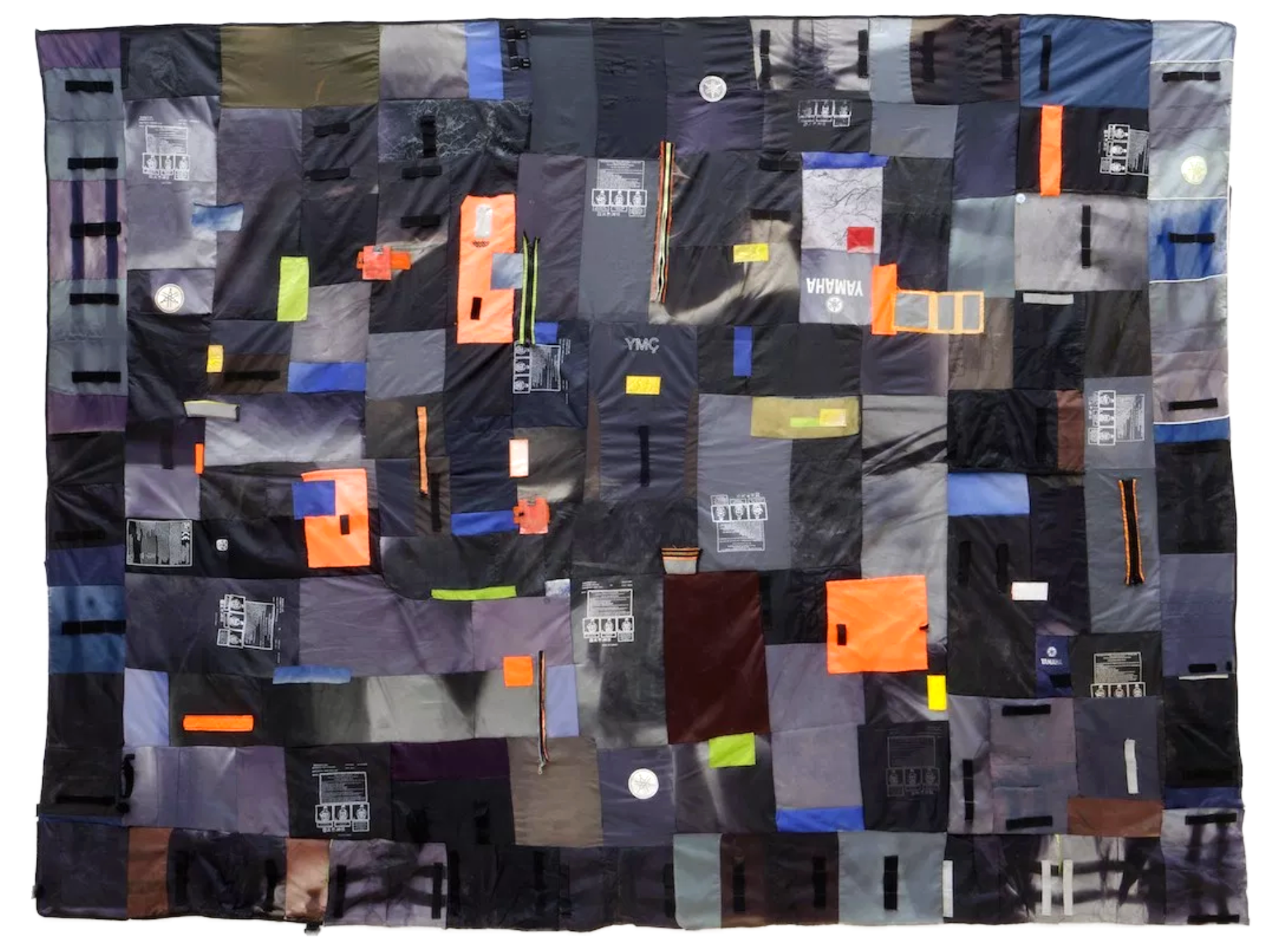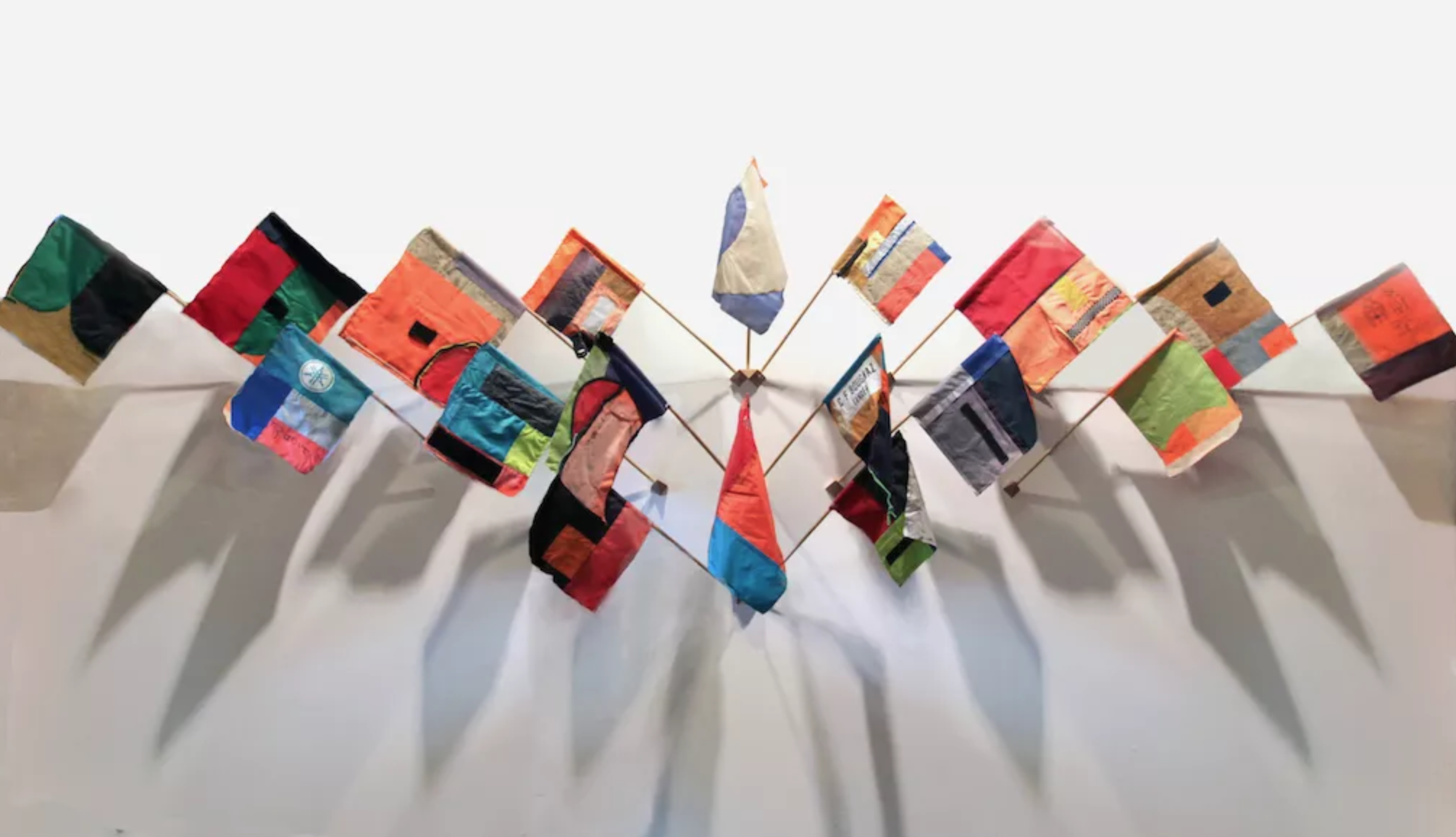Pamela Longobardi
United States of America + Greece

Pamela Longobardi
Night Flag of Lesvos (Soteria), 2019
Recovered life vests from Lesvos, Greece, and wood
103” x 135”

Pamela Longobardi
Signal Flags for Climate Change, 2017
Recovered life vests from Lesvos, Greece, thread and wood
Pamela Longobardi
Acts of Warning (semaphore), 2017
video, 5:57 minutes
Pamela Longobardi
Onar (repair the dream), 2020
video, 8:17 minutes
As part of Pamela Longobardi’s ongoing Drifters Project collecting and transforming ocean plastic, in 2016, her focus shifted from the global consumer plastic pollution of objects and nets to the discarded plastic life vests of the global refugee crisis. In May 2016, Pamela was invited to speak and screen her film Plastic Free Island at the International Small Island Studies Association conference held at the University of the Aegean in Mytilini, Lesvos, and managed to connect with a volunteer network engaging and assisting with unaccompanied male minors in camps of undisclosed location. She returned in December 2016 and volunteered in the open camp Pikpa and Lesvos Solidarity, who ran the camp for families. Drifters Project began a collaboration with refugees and Greek citizens of Safe Passage, a maker of bags and backpacks from the discarded vests that ran from 2016-2018, which enable thousands of dollars of direct aid donation to go to the refugees. Night Flag of Lesvos (Soteria), 2019, and Signal Flags for Climate Change, 2017, are works Pamela made from the scavenged and re-used life vests of the refugee crisis on the island of Lesvos, Greece, where over 600,000 migrants landed on its shores since 2015. The film Acts of Warning (semaphore), 2017, was originally displayed as a projection on an 8-foot-diameter weather balloon. This 360-degree video documents a series of public performances in Llansteffan, Wales; Kefalonia, Greece; and an unauthorized performance in Marco Polo Airport in Venice, Italy, during the Venice Biennale (June 14, 2017) utilizing the Signal Flags for Climate Change to spell messages in semaphore, the hand/flag signal language of distant communication in the Navy. Longobardi is spelling the code out behind her back while facing out to sea, functioning as scout or observer and relayer of a message of warning to observers approaching from behind. The message spelled here is “Prepare for climate change.”
Pamela is a conceptual artist grounded in modalities of forensic investigation, action, collaborative process, and social practice. She was born in New Jersey, the daughter of an ocean lifeguard and Delaware state diving champion, and worked as a firefighter, tree planter, scientific illustrator, archeological mapmaker, collaborative printer, artist, and educator. Her artwork involves sculpture, installation, film, performance, and social engagement, and is framed within a conversation on globalism and climate change. It addresses the geopolitics of the changing ocean as social and commodified space. In 2006, she created Drifters Project, an artistic research project focusing on contemporary global archeology: drifting plastic objects. After witnessing immense amounts of plastic regurgitated on remote beaches worldwide, her work shifted to collective art activism, now an international entity with thousands of participants resituating tons of material.
Plastic artifacts contain potential messages that can be decoded with self-reflection; material that has been exchanged with the ocean is a mirror to our world. Pamela engages citizens in active processes of cleaning as care: action as antidote to experience the transformative connective shift that occurs. Plastic is the geologic marker of the Anthropocene, Capitalocene, or most poignantly, Eremocene, the “Age of Loneliness.” (E. O. Wilson). Plastic production, dissemination, and zombie afterlife contributes to earth’s present sixth mass extinction. In addition to gallery/museum installations, Pamela does site work involving forms of distance messaging, such as mirror communication, semaphore, and S.O.S. messages shot by drone, as performative pieces, projecting messages of attention. This along with her studio-based painting practice involving phenomenology and chemistry make up the whole of her work.
Pamela is a conceptual artist grounded in modalities of forensic investigation, action, collaborative process, and social practice. She was born in New Jersey, the daughter of an ocean lifeguard and Delaware state diving champion, and worked as a firefighter, tree planter, scientific illustrator, archeological mapmaker, collaborative printer, artist, and educator. Her artwork involves sculpture, installation, film, performance, and social engagement, and is framed within a conversation on globalism and climate change. It addresses the geopolitics of the changing ocean as social and commodified space. In 2006, she created Drifters Project, an artistic research project focusing on contemporary global archeology: drifting plastic objects. After witnessing immense amounts of plastic regurgitated on remote beaches worldwide, her work shifted to collective art activism, now an international entity with thousands of participants resituating tons of material.
Plastic artifacts contain potential messages that can be decoded with self-reflection; material that has been exchanged with the ocean is a mirror to our world. Pamela engages citizens in active processes of cleaning as care: action as antidote to experience the transformative connective shift that occurs. Plastic is the geologic marker of the Anthropocene, Capitalocene, or most poignantly, Eremocene, the “Age of Loneliness.” (E. O. Wilson). Plastic production, dissemination, and zombie afterlife contributes to earth’s present sixth mass extinction. In addition to gallery/museum installations, Pamela does site work involving forms of distance messaging, such as mirror communication, semaphore, and S.O.S. messages shot by drone, as performative pieces, projecting messages of attention. This along with her studio-based painting practice involving phenomenology and chemistry make up the whole of her work.
about the artist

Pamela Longobardi was born in Glen Ridge, New Jersey., the daughter of an ocean lifeguard and the Delaware State diving champion, and currently lives in Atlanta, where she is Regents’ Professor at Georgia State University. Her artwork has been shown extensively across the U.S. and internationally. In 2006, she founded the Drifters Project, an international collaborative artistic research project focusing on ocean plastic pollution. Pamela’s artwork is framed within a conversation about globalism, conservation, and climate change and involves painting, photography, and installation to address the psychological relationship of humans to the natural world. In 2013, she won the prestigious Hudgens Prize, one of the largest art prizes in North America, and has an ongoing collaboration supported by the Ionion Center for Art and Culture in Kefalonia, Greece. As lead artist on the GYRE expedition, she was featured in the National Geographic film GYRE: Creating Art From a Plastic Ocean and in National Geographic magazine. She has appeared on The Weather Channel and on PBS public television numerous times, and her artwork on covers of SIERRA magazine and other national magazines. Pamela is Oceanic Society’s Artist-In-Nature, participating and leading international expeditions as artist/naturalist and “Plastic Interpreter.” She had a major exhibition of the long-term project in Kefalonia at the Goulandris Museum of Natural History in Athens, Greece. She co-directed the award-winning short film Plastic Free Island (2015) documenting the six-year project in Kefalonia, Greece, that premiered at the Oceanographic Museum in Monaco. Recent work engaged the refugees and citizens on the island of Lesvos, Greece.
interview